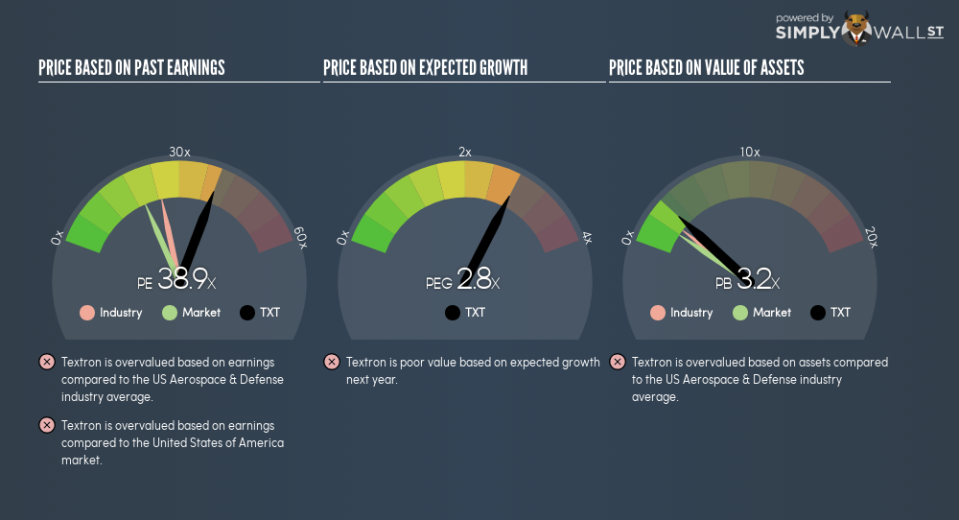Is Textron Inc’s (NYSE:TXT) PE Ratio A Signal To Sell For Investors?

The content of this article will benefit those of you who are starting to educate yourself about investing in the stock market and want to begin learning about how to value company based on its current earnings and what are the drawbacks of this method.
Textron Inc (NYSE:TXT) is currently trading at a trailing P/E of 38.9, which is higher than the industry average of 24.9. Although some investors may see this as unappealing, it is important to understand the assumptions behind the P/E ratio before making judgments. Today, I will deconstruct the P/E ratio and highlight what you need to be careful of when using the P/E ratio.
Check out our latest analysis for Textron
Breaking down the P/E ratio
P/E is a popular ratio used for relative valuation. It compares a stock’s price per share to the stock’s earnings per share. A more intuitive way of understanding the P/E ratio is to think of it as how much investors are paying for each dollar of the company’s earnings.
P/E Calculation for TXT
Price-Earnings Ratio = Price per share ÷ Earnings per share
TXT Price-Earnings Ratio = $69.61 ÷ $1.788 = 38.9x
On its own, the P/E ratio doesn’t tell you much; however, it becomes extremely useful when you compare it with other similar companies. Our goal is to compare the stock’s P/E ratio to the average of companies that have similar attributes to TXT, such as company lifetime and products sold. A common peer group is companies that exist in the same industry, which is what I use. TXT’s P/E of 38.9 is higher than its industry peers (24.9), which implies that each dollar of TXT’s earnings is being overvalued by investors. This multiple is a median of profitable companies of 25 Aerospace & Defense companies in US including Optex Systems Holdings, Environmental Tectonics and Vectrus. You could think of it like this: the market is pricing TXT as if it is a stronger company than the average of its industry group.
Assumptions to watch out for
Before you jump to conclusions it is important to realise that there are assumptions in this analysis. Firstly, that our peer group contains companies that are similar to TXT. If this isn’t the case, the difference in P/E could be due to other factors. Take, for example, the scenario where Textron Inc is growing profits more quickly than the average comparable company. In that case, the market may be correct to value it on a higher P/E ratio. We should also be aware that the stocks we are comparing to TXT may not be fairly valued. Thus while we might conclude that it is richly valued relative to its peers, that could be explained by the peer group being undervalued.
What this means for you:
You may have already conducted fundamental analysis on the stock as a shareholder, so its current overvaluation could signal a potential selling opportunity to reduce your exposure to TXT. Now that you understand the ins and outs of the PE metric, you should know to bear in mind its limitations before you make an investment decision. Remember that basing your investment decision off one metric alone is certainly not sufficient. There are many things I have not taken into account in this article and the PE ratio is very one-dimensional. If you have not done so already, I highly recommend you to complete your research by taking a look at the following:
Future Outlook: What are well-informed industry analysts predicting for TXT’s future growth? Take a look at our free research report of analyst consensus for TXT’s outlook.
Past Track Record: Has TXT been consistently performing well irrespective of the ups and downs in the market? Go into more detail in the past performance analysis and take a look at the free visual representations of TXT’s historicals for more clarity.
Other High-Performing Stocks: Are there other stocks that provide better prospects with proven track records? Explore our free list of these great stocks here.
To help readers see past the short term volatility of the financial market, we aim to bring you a long-term focused research analysis purely driven by fundamental data. Note that our analysis does not factor in the latest price-sensitive company announcements.
The author is an independent contributor and at the time of publication had no position in the stocks mentioned. For errors that warrant correction please contact the editor at editorial-team@simplywallst.com.

 Yahoo Finance
Yahoo Finance 
